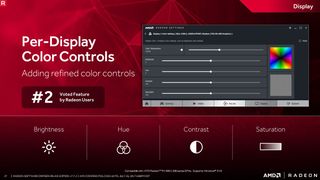Radeon Software Crimson ReLive Update Adds Features For Streamers, Power Conservation

AMD regularly releases updates to its Radeon Software Crimson ReLive driver suite, but they are usually small incremental changes. This month, AMD packed many new features and improvements into Radeon Software Crimson ReLive 17.7.2, including new features for streamers, new power draw settings in Radeon Wattman, and deeper support for Radeon Chill technology.
Improved Features For Streamers
The latest update to AMD's driver software suite includes a host of improvements for game streamers. Previously, Radeon ReLive supported a maximum recording bitrate of 50Mbps, which provided reasonable image quality on live streams. The new version of the driver now supports 100Mbps recording, which results in crisper visuals for your spectators. Radeon ReLive 17.7.2 also introduces webcam transparency so you can see a game's HUD through your camera overlay.



Radeon ReLive 17.7.2 also includes a series of new notifications for live streamers. Now, when you start recording, you’ll see a timer overlay to let you know how long you’ve been recording your gameplay. AMD also introduced notifications that pop up to let you know that an instant replay video saved, or when there are network connectivity issues that could impact your stream quality.
Furthermore, Radeon ReLive includes new audio control options that let you adjust the microphone volume for your streams and boost the volume of the game’s audio. The new driver also introduces a push-to-talk feature for streamers that lets you assign a keyboard or mouse input to activate your microphone.
Power Draw Reduction
In the last couple of years, AMD has put a lot of work into reducing the power draw of its graphics cards. Newer GPUs from team red draw far less power than previous generation chips, and the company has also introduced software to reduce the power needs of older R9-series cards.

AMD’s Radeon Wattman is a suite of overclocking (and now underclocking) features baked into the Radeon Software Crimson ReLive driver. Wattman offers options to adjust GPU and memory clock speeds, adjust the fan speed, set temperature targets, and control voltage. The latest Radeon ReLive update introduces two new power options: Memory Underclocking and Power State Controls.
The Memory Underclocking feature allows you to adjust the memory clock speed to reduce power draw and, potentially, increase stability for higher graphics engine overclocks. Power State Controls lets you rein back the operating system’s power to affect the power state and put it in your hands.
Stay on the Cutting Edge
Join the experts who read Tom's Hardware for the inside track on enthusiast PC tech news — and have for over 25 years. We'll send breaking news and in-depth reviews of CPUs, GPUs, AI, maker hardware and more straight to your inbox.
Last year, AMD introduced a new component of Wattman called Radeon Chill, which lets you control the maximum frame rate your GPU can output. Radeon Chill reduces power draw by eliminating the possibility for your graphics card to render frames at a rate that far exceeds your LCD’s capacity to display them.
AMD launched Radeon Chill with 18 supported DX9 and DX11 games in December 2016. The list hasn't expanded in the last seven months, but it more than doubled with the launch of Radeon ReLive 17.7.2. Now, Radeon Chill supports DX12 and Vulkan, and AMD added 21 titles to the list of supported games. That’s not a lot of games in the grand scheme of things, but the titles that AMD targeted include some of the most popular games out there, such as Dota 2, League of Legends, and Rocket League. Radeon Chill also supports GTA V, Doom, and ARK: Survival of the Fittest—just to name a few. AMD also made Radeon Chill into a per-game option instead of a global setting.
Multi-GPU Support
When AMD released Radeon Chill, the technology had limited applications. It didn’t work if you had more than one GPU in your system and it worked only with desktop-class hardware. AMD is now extending Radeon Chill support to a wider range of hardware configurations. The power draw reduction technology now supports multi-GPU setups, which AMD said can lower power consumption by up to 29%. Radeon Chill is also now supported on laptops.

Radeon Chill technology can also now be applied to mobile-class AMD GPUs, which can improve battery life by as much as 30% when gaming on a 1080p display. Radeon Chill also supports AMD’s XConnect Technology to help improve the efficiency of external graphics cards.
Radeon Chill isn’t the only AMD technology that now supports multi-GPU configurations. AMD’s Frame Rate Target Control technology now works with Crossfire enabled. (FRTC also now includes DX12 support so you can use it on a wider range of games.)
Independent Per Display Color Control
AMD’s Radeon Software Crimson ReLive 17.7.2 also introduces per-display color control. If you have more than one monitor, you can now calibrate the color for each display independently. This feature is especially helpful for gamers who use multiple different models of display. For example, an LCD panel from Samsung likely wouldn’t offer the same color reproduction as an LG panel. With AMD’s latest driver, you would be able to adjust the brightness, hue, contrast, and saturation of each panel so they match.

Enhanced Sync
The new Radeon Software Crimson ReLive driver also introduces a new frame rate synchronization technology that replaces VSync and complements FreeSync. You can read more about Enhanced Sync here.
AMD’s Radeon Software Crimson ReLive 17.7.2 is available now. You can download a copy from AMD’s website.
Kevin Carbotte is a contributing writer for Tom's Hardware who primarily covers VR and AR hardware. He has been writing for us for more than four years.
-
bigpinkdragon286 Enhanced Sync is only for Polaris or newer architectures.Reply
The new 17.7.2 are the first drivers to officially drop support for Windows 8 and 8.1.
Most Popular




